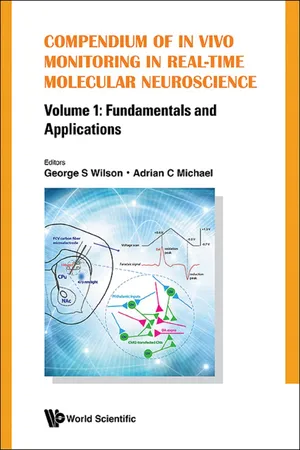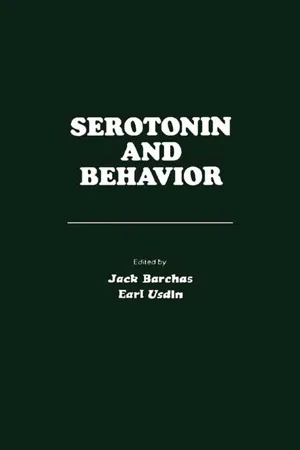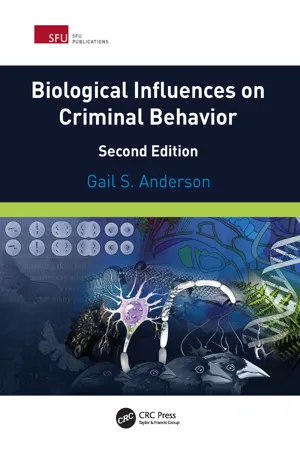Psychology
Serotonin Research
Serotonin research in psychology focuses on the neurotransmitter serotonin and its role in various psychological processes. Studies have linked serotonin to mood regulation, sleep, appetite, and cognition, making it a key target for understanding and treating mental health disorders such as depression, anxiety, and schizophrenia. Research in this area often explores the effects of serotonin levels, receptors, and medications that target the serotonin system.
Written by Perlego with AI-assistance
Related key terms
5 Key excerpts on "Serotonin Research"
- eBook - ePub
Compendium Of In Vivo Monitoring In Real-time Molecular Neuroscience - Volume 1: Fundamentals And Applications
Volume 1: Fundamentals and Applications
- George S Wilson, Adrian C Michael(Authors)
- 2014(Publication Date)
- WSPC(Publisher)
CHAPTER 12 PROBING SEROTONIN NEUROTRANSMISSION: IMPLICATIONS FOR NEUROPSYCHIATRIC DISORDERS Kevin M. Wood, David Cepeda and Parastoo Hashemi Wayne State University 12.1 INTRODUCTIONSerotonin is a unique neurotransmitter. About 98% of the body’s serotonin is located outside of the brain (Cooper et al., 2003), however, as a neuromodulator it plays important, expansive roles. Serotonin is thought to control many essential processes including appetite, sleep, mood, memory, cognition, movement and reward. Imbalances in the serotonergic system are associated with many neuropsychiatric disorders.Autism (Chugani et al., 1997; Sutcliffe et al., 2005), post-traumatic stress disorder (PTSD) (Lee et al., 2005), anxiety (Lesch et al., 1996; Sen et al., 2004; Ramboz et al., 1998), schizophrenia (Inayama et al., 1996; Laruelle et al., 1993), bipolar disorder (Furlong et al., 1998; Young et al., 1994), and addiction (Muller et al. 2007; Sellers et al., 1992) all display distinct deregulations of the serotonergic system.The most notorious of serotonin’s associations, however, is depression. Depression debilitates millions of Americans every year; it is a mental illness that can destroy feelings of joy gained from previous exciting activities. Fatigue, hopelessness, irritability, and excessive sadness can plague the sufferer. In 2011, antidepressants and antipsychotics dominated the pharmaceutical market (Lindsley, 2012).Modern antidepressants typically exaggerate serotonin’s effects in the synapse by slowing down its reuptake. Despite their mainstream usage, antidepressants generate controversy because of variable clinical efficacy (Smith et al., 2002; Cipriani et al., 2009) and systemic side effects (Ferguson, 2001; Masand and Gupta, 2002). Moreover, it is common for patients to take antidepressants for 3–4 weeks without experiencing therapeutic benefit (Gelenberg and Chesen, 2000; Onder and Tural, 2003). During this period patients can experience heightened depression and suicidal tendencies (Stone et al., 2009). - eBook - ePub
- Jack Barchas(Author)
- 2012(Publication Date)
- Academic Press(Publisher)
The second approach involves the utilization of primate models for the study of psychiatric disorders. In an earlier session, papers were presented dealing with the effects of an inhibitor of serotonin formation on behavior in groups of monkeys. The use of primate models, such as separation, might provide means of determining the effects of altering amines in relation to the behavioral changes. Such studies could provide data that could potentially be useful clinically.Passage contains an image
ROLE OF SEROTONIN IN AFFECTIVE DISORDERS
A. CoppenPublisher Summary
This chapter discusses the role of serotonin in affective disorders. The investigation of the biochemistry of the affective disorders and mental illness in general presents a variety of difficult and apparently often insuperable problems. There is evidence of a disturbance of 5-hydroxytryptamine in the central nervous system of depressive and manic patients. The evidence suggests that clinical recovery is not accompanied by any change in this abnormality and therefore, it is a predisposition that requires another factor to produce the clinical picture of depression and mania. However, measures to increase amines, especially 5-hydroxytryptamine, by administering large doses of tryptophan and monoamine oxidase inhibition is an effective antidepressant treatment, and it is, therefore, probable that the change in amines has a direct relationship with some of the symptoms of a depressive illness.The investigation of the biochemistry of the affective disorders and mental illness in general presents a variety of difficult and apparently often insuperable problems. The absence of any convincing animal model for depression and mania compels the investigator to turn to experimentation on patients. These investigations present a wealth of ethical, practical and theoretical problems. For example, it is extremely difficult to get any information about processes in the brain, in vivo , in man – yet, presumably, it is this organ that is concerned in the aetiology of mental illness. The nearest one can get to the central nervous system, in practice, is the lumbar cerebrospinal fluid, although recent studies (Bulat and Zivkovic, 1971 - eBook - ePub
- Nutt, David(Authors)
- 2021(Publication Date)
- Waterside Press(Publisher)
Chapter 4Struggles with Serotonin
‘Is it safe?’ Professor Gelder asked. ‘I think so,’ Dr Cowen replied. ‘Are you sure it’s going to work?’ the Prof responded. From inside the research cubicle came a loud retort: ‘If we knew it was going to work it wouldn’t be research!’This last remark was from me and I was about to have my serotonin system tested in a powerful way by my colleague and research partner Phil Cowen. The good news is I lived to tell the tale, but it was a rocky and revealing ride.Serotonin is now a well-known neurotransmitter — in the same league of popular knowledge as are noradrenaline, dopamine and endorphins. It has become synonymous with depression and I have had patients tell me that they think they are serotonin deficient and would like it boosted by a selective serotonin re-uptake inhibitor (SSRI) drug such as Prozac or Seroxat. These medicines enhance the available amount of functional serotonin in the brain by preventing it being taken back up into the nerves from which it came. There is therefore more serotonin to act on the multitude of different serotonin receptors in the brain, which currently stand at 15, so more than for any other neurotransmitter. The plethora of different receptors means that serotonin can do many different things in the brain. In reality, serotonin is involved in almost all brain functions — from perception and cognition through to mood, sex and sleep. The only major brain functions that serotonin doesn’t play much of a role in are movements and touch/balance.So, what aspects of serotonin were we trying to study? In those days — the early 1980s — the drugs we used to treat depression were from the 1950s, either the tricyclics or the monoamine oxidase inhibitors (MAOIs). Both these classes of anti-depressant were discovered by serendipity. Each was being tested for another indication and observant clinicians noted that they had effects on mood. The first MAOI was isoniazid that was being developed as a treatment for tuberculosis. It had little effect on the lesions in the lungs but despite that did improve the patient’s mood. Subsequently this and related compounds, e.g. phenelzine were tested and found effective in depressed people. - eBook - ePub
Stress: Physiology, Biochemistry, and Pathology
Handbook of Stress Series, Volume 3
- George Fink(Author)
- 2019(Publication Date)
- Academic Press(Publisher)
Chapter 10Serotonin in Stress
Maarten van den Buuse, and Matthew W. Hale School of Psychology and Public Health, La Trobe University, Melbourne, VIC, AustraliaAbstract
Serotonin is implicated in the pathology of several psychiatric disorder, including major depression, general anxiety disorder, posttraumatic stress disorder, and schizophrenia. Stress plays a role in all these diseases, either as a causative factor or to exacerbate symptoms. Stress affects several aspects of serotonergic signaling in the brain and, conversely, serotonergic drugs can modulate the effects of stress. This chapter will summarize the complex and reciprocal interrelationship between stress and brain serotonin signaling with a focus on psychiatric disorder. The literature shows that stress effects on the serotonin system are regionally different throughout the brain and are dependent on the type of stress, its duration, the serotonergic marker measured, and individual differences in resilience and genetic background.Keywords
5-HT1A receptor; Depression; Glucocorticoid receptors; Hippocampus; PTSD; Raphe nucleus; Schizophrenia; Serotonin; Serotonin transporter polymorphismOutline- Introduction: Stress, Serotonin, and Human Psychopathology
- Effect of Stress on Serotonin Parameters in the Brain
- Animal Models
- Human Imaging
- Effect of Serotonergic Drugs on Stress Responses: Serotonin and HPA Axis Activity
- Animal Models
- Human Studies
- Stress, Serotonin, and Human Psychopathology
- Anxiety, PTSD, and Depression
- Psychoses
- Conclusions
- References
Introduction: Stress, Serotonin, and Human Psychopathology
It is widely accepted that stress plays a role in the pathology of several psychiatric disorders. This is most notable in mood and anxiety disorders such as major depression, general anxiety disorder, and posttraumatic stress disorder (PTSD) but, similarly, stress has been shown to play a role or exacerbate symptoms in psychotic illnesses, such as schizophrenia (Fig. 10.1 , ➀). Serotonin systems in the brain are implicated in all these disorders (Fig. 10.1 , ➁). There is a wealth of literature showing that stress affects serotonergic signaling in the brain (Fig. 10.1 , ➂) and thereby influences disease development. Conversely, serotonergic drugs can modulate or mitigate the effects of stress in psychopathology (Fig. 10.1 - eBook - ePub
- Gail Anderson(Author)
- 2019(Publication Date)
- CRC Press(Publisher)
Chapter 7 , the HPA axis is an interaction between the hypothalamus (a region of the brain that links the neural system to the endocrine system), the pituitary gland (found in the brain and involved in the production and regulation of many different hormones), and the adrenal glands (found on the kidneys and also involved in the production and regulation of a number of hormones, including adrenalin, as well as steroids). The HPA axis is crucial in the regulation of many of our internal systems, such as the reproduction system, cardiovascular system, immune system, and central nervous system. Most importantly, it is involved in mood regulation and its dysfunction is related to many disorders such as attention deficit hyperactivity disorder (ADHD), bipolar disorder, borderline personality disorder, major depressive disorder, and alcoholism. It plays a major role in the effects of stressors on an individual.Serotonin is thought to act as a behavioral inhibitor, and so, it normally displays an inverse relationship with impulsive-aggressive behavior. That is, the lower the serotonin levels, the more impulsive-aggressive the person is; the higher the levels are, the calmer the person is.4A link between low levels of serotonin and aggression was first shown in a study in 1959, and the findings have been confirmed many times since then. Lower levels of serotonin (or its metabolites or precursors) have been associated with increased aggression, irritability, hostility, and impulsivity.4 The increase in aggression may occur because such behaviors are normally inhibited by a balance of neurotransmitters such as serotonin and dopamine. People with lower levels of these neurotransmitters lose that balance, so their behavior is no longer inhibited. Serotonin has many other functions, such as mood regulation, which could affect people more indirectly and push them into aggression. However, it is rare for a biological system to be influenced by just one thing. Usually, there are inhibitory and excitatory influences that interact and lead to some form of balance between the factors we can observe behaviorally.4Serotonin and suicidal behavior
The first serotonin behavior studies, in the late 1960s, looked at its role in suicidal behavior. Suicide can be considered an act of violence although it is directed at oneself. The early research looked at the levels of serotonin and its metabolite 5-HIAA in the brains of individuals who had committed suicide compared with those who had died in accidents, and researchers found reduced levels of serotonin in the suicide victims compared with the accident victims.5 In further experiments, on living people, depressed patients who had a history of suicide attempts were found to have lower levels of 5-HIAA than patients who were clinically depressed but had never attempted suicide. This relationship was particularly clear in patients who had used violent methods in their suicide attempts.6 Obviously, not all suicides have low serotonin levels, but this relationship has been repeated in so many studies, some sort of link is clear. Dysfunction within the serotonergic system is presently the most commonly studied predisposition for suicide.7
Index pages curate the most relevant extracts from our library of academic textbooks. They’ve been created using an in-house natural language model (NLM), each adding context and meaning to key research topics.




